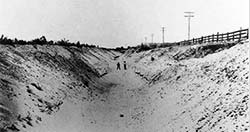Trenton, 1872 ~ Index
Trenton was at first located on what was known as the Big Range, and was on the freight road to Montana, later in 1890 it became a shipping point on the Oregon Shortline Railroad.

The section of the county where Trenton is located was used as a grazing range for stockmen from Richmond and Smithfield. Reese and Kewley ranged cattle here. The main freight road from Corinne to Montana went through this part of the county. This road was traveled a good deal by freighters and the stage coaches. The freight loads were hauled by bull and mule teams. Mules and horses were used for the stage coaches. This was the main route out of the valley to the north. The mines in Montana made brisk trading between Utah cities and the mining towns of Montana. The extension of the railroad from Utah into Idaho and Montana in 1879 and 1880, did away with the freighting and stage coach travel over this route.
The McCombs family located on Bear River near Trenton, in 1869. The first real settlement of Trenton began in 1872. The families of James Hill, Joseph Wood, Stephen Malan, Joe Harmison, Sam Harmison, Joan Lindlsay and B.Y. Benson, located here. The first houses in the settlement was moved from Weston, Idaho and rebuilt just east of Trenton by Peter Christensen. Parley Christensen, who ran for President of the United States on the Labor ticket at one time, was born in this house.
James Jardine of Clarkston was appointed as the Presiding Elder of Trenton. B.Y. Benson was the first bishop. Bishop William B. Preston from Logan organized the settlement and named it "Trenton" after Trenton, New Jersey, from which city a number of the early settlers had come. The first school was held in the home of Andrew McCombs. Later a log schoolhouse was built. The house logs were obtained in the hills east of Swan Lake, In Idaho. Charity Ames was one of the first schoolteachers. Myron Butler conducted a private school for a short time.
The settlers traded for some of their supplies at Weston, Idaho. To come to Logan, they forded the Reese Ferry over Bear River where Benson was being located. The mail came over this ferry. Bear River was considerably lower than the elevation of the settlement. It was too expensive and difficult to take out a canal from Bear River for irrigation at this time. The people had to rely mostly on dry farming. They used wells for their drinking water. These conditions continued until 1898.
In order for Trenton and all those lands south and east of Newton and where Amalga is to be developed, it was necessary to get irrigation water. Naturally they looked to the Bear River. In 1898, an irrigation company was formed with Charles Wood, M.W. Butter, Parley Merrill, William Bingham, John Jorgeson and Henry Ballard, as the officers.
After this canal was constructed there was a high maintenance cost. The high waters washed out bridges and until the banks got well set, there were many washouts. Many times the crops suffered before the water could be put in the canal again. A number of times the bridges over Bear River were washed out and it was necessary to use row boats or swim horses to get across the river. The West Cache Canal made it possible for more intensive crops to be grown in the Trenton district. As the railroad passed through the town, it became quite a center for some large grain elevators and milling. Much of the grain in the Clarkston area was hauled to Trenton. Trenton developed quite rapidly and a business section was established.